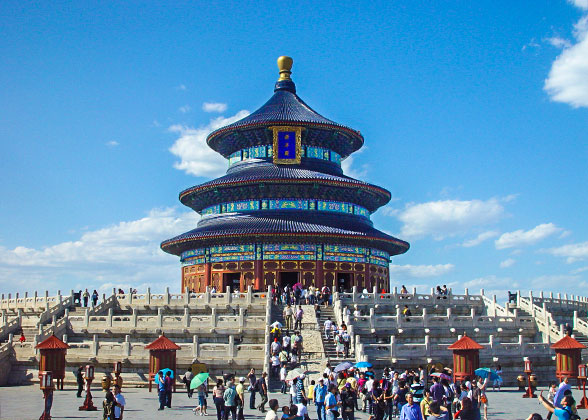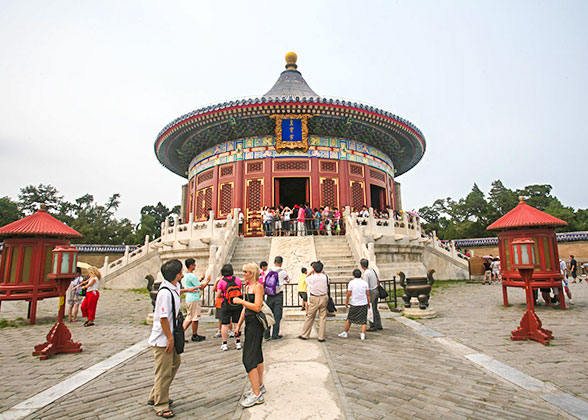Temple of Heaven
First built in 1420, the 18th year of the reign of Emperor Yongle of the Ming Dynasty (1368 - 1644), the Temple of Heaven was enlarged and rebuilt during the reigns of the Ming emperor Jiajing and the Qing emperor Qianlong. In 1988, it was opened to the public as a park, showing ancient philosophy, history and religion. Its grand architectural style and profound cultural connotation give an insight into the practices of the ancient Eastern civilization.
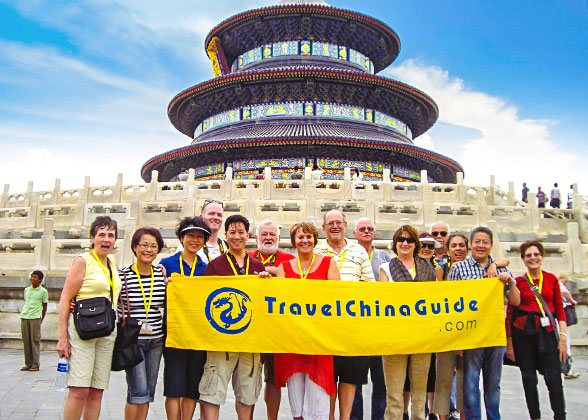 |
| Our Tour Group in the Temple of Heaven |
Covering an area of 2,700,000 square meters (3,529,412 square yards), the Temple of Heaven Beijing is larger than the Forbidden City. As the 'Sons of Heaven', Chinese emperors were precluded from building a dwelling for themselves that was greater than the earthly residence dedicated to Heaven hence the difference in overall size of the two complexes.
The temple is enclosed by a long wall. The northern part within the wall is semicircular symbolizing the heavens and the southern part is square symbolizing the earth. The northern part is higher than the southern part. This design shows that the heaven is high and the earth is low and the design reflected an ancient Chinese thought of 'the heaven is round and the earth is square'.
Temple of Heaven is divided by two encircling walls into an inner part and outer part. The main buildings lie at the south and north ends of the middle axis of the inner part. The most magnificent buildings are the Circular Mound Altar (Huanqiutan), the Imperial Vault of Heaven (Huangqiongyu) and the Hall of Prayer for Good Harvest (Qiniandian) from south to north.
Recommended Tours
Temple of Heaven Touring Routes
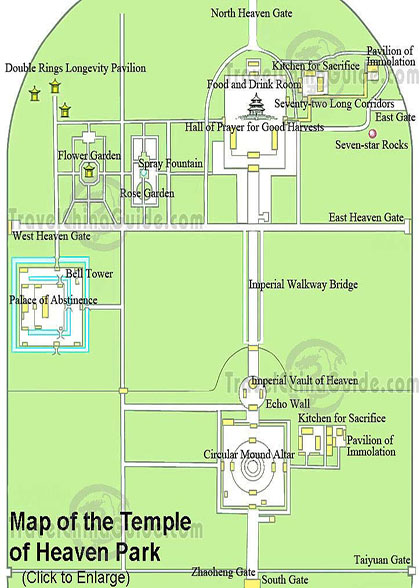 |
| Map of Temple of Heaven (Click to enlarge) |
2. North Gate → Hall of Prayer for Good Harvests → East Annex Hall → West Annex Hall → Danbi Bridge → Echo Wall → Imperial Vault of Heaven → Three Echo Stones → Danbi Bridge → South Divine Kitchen → Circular Mound Altar → Lingxing Gates → Palace of Abstinence → Divine Music Administration
Located in the southern part of this area, The Circular Altar Mound is actually the Temple of Heaven in the practical sense. During the Ming and Qing Dynasties, the emperors would offer sacrifice here to Heaven on the day of the Winter Solstice every year. Its famous buildings include the Lingxing Gates, the Lantern Viewing Pole, the Terrace of Worshipping Heaven, the Heaven Heart Stone, the Firewood Stove and the Divine Kitchen Courtyard.
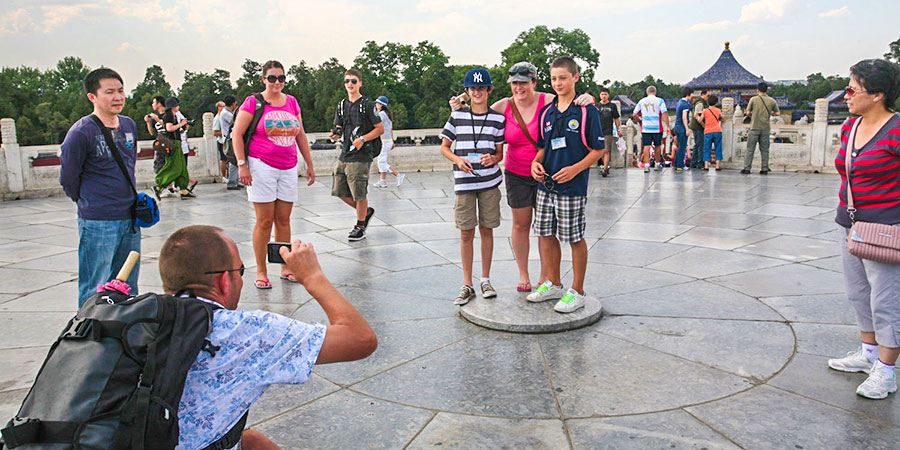 |
| Tourists on the Circular Mound Altar |
Danbi Bridge
Also called the Vermilion Steps Bridge, the Danbi Bridge connects the northern part and the southern part. The south end of the Bridge is lower than its north end. The emperors believed that they could go to heaven by this Bridge, hence the name, Sacred Way. The Sacred way had three routes, the central one was the Imperial Route exclusively used by the Emperor and on one side was the Princes’ Route. On the other side was the route for high officials.
Across the Danbi Bridge, you will come to the Hall of Prayer for Good Harvests. It is a big palace with round roof and three layers of eaves, where the emperor held the worship ceremonies to pray for good weather and abundant harvests. It is the earliest building of the Temple of Heaven. It is a complex consisting of the Hall of Prayer for Good Harvests and the Altar for Grain Prayers.
|
|
Located in the southwest of the Altar of Prayer for Good Harvests, the Palace of Abstinence is where the emperor fasted before the Heaven Worship Ceremony began. It has several distinctive buildings, such as the Beamless Hall, the Rest Palace, the Belfry, etc.
Located to the southwest of the Palace of Abstinence, the Divine Music Administration is one of the five major buildings in this scenic area. This was the location of the managing body for the ceremonial musical instruments as well as the place where the sacrificial ritual was devised and rehearsed. This was the most important ritual music academy of the Ming and Qing dynasties.
Established by Emperor Yongle of the Ming Dynasty, the annual Worship of Heaven ceremony by the emperor took place here. The ceremony was subject to special regulations for its preparation, place, time, procedures, music and dance. This ceremonial practice confirmed the divine right of emperor and the religious belief of the ancient Chinese people.![]() Ten facts of Temple of Heaven
Ten facts of Temple of Heaven![]() FAQs on Temple of Heaven
FAQs on Temple of Heaven
Today's Temple of Heaven
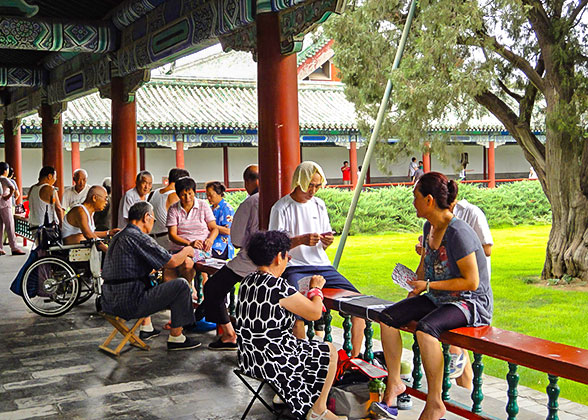 |
| Leisure activities of Beijingers in the park |
There are over 60,000 varieties of tree. The most famous tree is the grandfather tree - a 500-year-old Nine-Dragon Cypress with branches like nine dragons winding with each other. These trees create a quiet environment and an ideal resort for the locals to do their morning exercise. Residents living near the this place enjoy many activities here, such as running, cycling, singing, dancing, playing chess, flying kites, etc. You can become involved personally in these activities and experience the leisure pursuits of local people.
How to get to Temple of Heaven
South Gate: Take bus 36, 958 or Zhuan 202 to Tiantan Nanmen Station.
West Gate: Take bus 2, 7, 20, 36, 53, 72, 93, or 120 and get off at Tiantan Ximen Station.
North Gate: Take bus 6, 34, 35, 36, 72 or 106 and get off at Tiantan Beimen Station.
Take Subway Line 5 to Tiantan Dongmen Station; leave from Exit A and you'll find the East Gate of the Park.
Take Subway Line 8 to Tianqiao Station, take Exit C, walk eastward you will see the west gate.
Ticket Fee
| Ticket Type | Apr. - Oct. | Nov. - Mar. |
|---|---|---|
| Entrance Fee | CNY 15 | CNY 10 |
| Hall of Prayer for Good Harvests, Circular Mound Altar & Echo Wall | CNY 20 | CNY 20 |
| Divine Music Administration | CNY 10 | CNY 10 |
| Combo Ticket (including the entrance fee & above attractions) | CNY 34 | CNY 28 |
| Audio Guide | Position: At the four gates Time: 8:00—17:00 Languages: Cantonese, English, Japanese, Korean, French, German, Spanish Rental: CNY 40; CNY 100 as deposit. | |
Opening Hours
| Apr. - Oct. | Nov. - Mar. | |
|---|---|---|
| Temple of Heaven | 1. North, East, South and West Gates: 06:00 - 22:00; stop entering at 21:00 2. Main attractions inside: 08:00 - 18:00; stop entering at 17:30; close on Mondays except for puclic holidays | 1. North, East, South and West Gates: 06:30 - 22:00; stop entering at 21:00 2. Main attractions inside: 08:00 -17:00; stop entering at 16:30; close on Mondays except for puclic holidays |
| Recommended Time for a Visit | 1.5 hours | |

